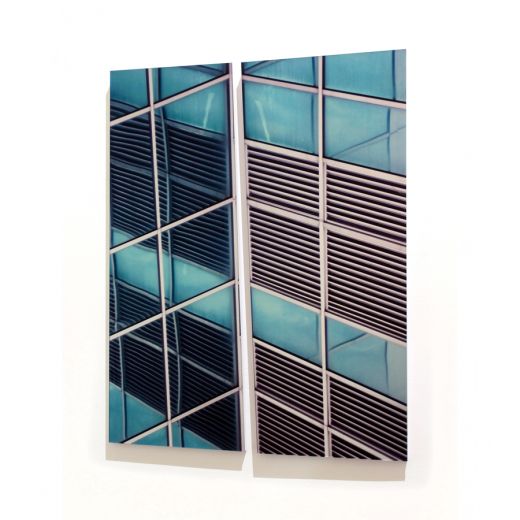felecia chizuko carlisle: facade
Naomi Fry

Felecia Chizuko Carlisle, “Half Rest,” 2012. Archival digital print on mirrored acrylic sheet, MDF. Photo courtesy of Dorsch Gallery.
The whole structure was conceived in two dimensions: the one satisfactory view of it comes at a distance of twenty stories above the street, and three blocks away, immediately facing the front elevation. Now curiously, the Paramount site has a unique possibility… unlike most of our buildings on gridiron streets, it can be approached. This unique possibility was completely forgotten; more than that, it was absurdly misused, with the result that the upper stories rise against the sky, above Broadway, with the immense solidity of a slab of chewing gum.
Unknowable to street-level passersby—or, at least, knowable only in obscure fragments—the Paramount Building embodied for Mumford the lack of an animated, productive relationship between a city’s inhabitants and their architectural environment. As Mumford noted, the Paramount—as well as most other skyscrapers in their indifferent enormity—tended to induce passivity in whoever approached it, as if declaring: “Brain: be silent! Eye: be still!”
While 1920s New York is certainly not 2010s Miami, the work of the artist Felecia Chizuko Carlisle still grapples with the same type of urban torpor described by Mumford. At her recent solo show at Dorsch Gallery, the Miami-based Carlisle drew strongly on her street-level encounters with skyscraper architecture. Resituating slivers of Miami’s built environment in the exhibition space, the artist both mimicked and subverted the imposing, impersonal environment of the city’s downtown area.
Printing (and, in one case, projecting) digital images of building façades on the reflective acrylic surfaces of variously shaped, smallish geometric wood objects, Carlisle installed these in the gallery space, where they perched nervously, tenuously—folded in the seam between two walls, as if poured down the side of a white wooden table, fluttering jaggedly at eye-level. And while these objects’ viewing experience seemed in one way to repeat the two-dimensional, fragmented effect Mumford railed against in his critique, Carlisle’s work in fact cuts the modern high-rise down to size. That architecture’s phallic impenetrability is shattered here, and becomes more complex, but more engaging too.
Modestly proportioned though they are, the sculptures snare our gaze and body, confuse us optically and physically. Are these our own shoulders, our own arms and ears and eyes, suddenly emerging out of the supposed opacity of a building’s window, the greenish slats of its shutters? Is the patterned latticework that we see on a wall the shadow of a mirror, or the projection of a building’s balconies on that mirror? In Carlisle’s pieces, we remain at ground level while still becoming one with the city’s skyscrapers. It’s a reciprocal shattering that activates the viewer, turning her into a participant in the urban environment, rather than just a spectator.










